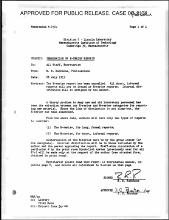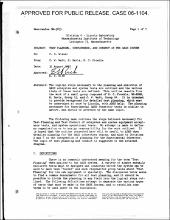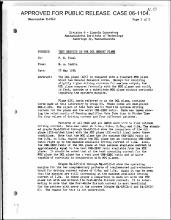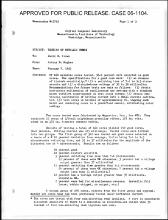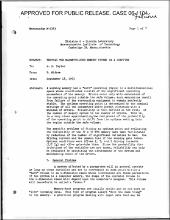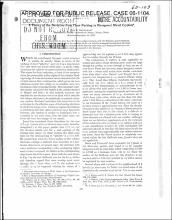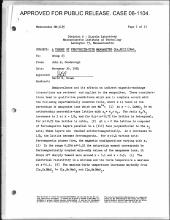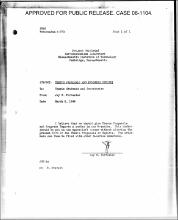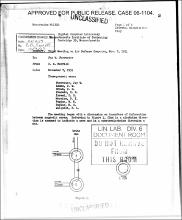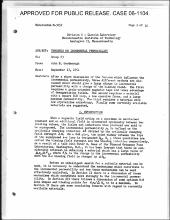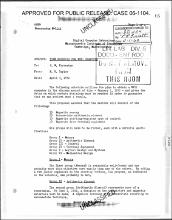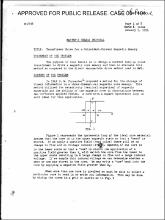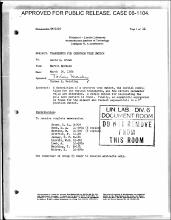Browsing Project Whirlwind Reports by Title
Now showing items 1610-1629 of 1719
-
T.I.R. release of operational specifications and XD-1 equipment specifications
(Lincoln Laboratory - Division 6, 1955-07-28)Technical Information Releases were used for equipment specifications and operational specifications for both the prototype and production machines. -
Tentative Cathode Estimates for 256²x33 and 128²x33 Core Memories
(Lincoln Laboratory - Division 6, 1954-08-06)The largest number of cathodes for a 256²x33 memory and 128²x33 memory is estimated to be 4756 and 1912 respectively. -
Termination of E-Series Reports
(Lincoln Laboratory - Division 6, 1953-07-28)The E-series report has been cancelled. All short, informal reports will now be issued as M-series reports. Internal distribution will be assigned by the author. -
Test planning, concurrence, and conduct in the SAGE system
(Lincoln Laboratory - Division 6, 1955-08-31)The logical steps necessary to the planning and execution of SAGE subsystem and system tests are outlined and the various kinds of these tests are defined. -
Test program for 1954 Cape Cod System
(Lincoln Laboratory - Division 6, 1955-07-28)In the letter from the SAGE Test Committee, Subject: Coordination Direction of 1954 Cape Cod System, 29 June 1955, the suggestion was made that planning, maintenance, operation and evaluation in the 1954 Cape Cod System ... -
Test Results on the DCL Memory Plane
(Lincoln Laboratory - Division 6, 1954-05-28)The DCL plane (C25) is compared with a standard MTC plane which has General Ceramics cores. Except for requiring slightly higher driving currents for maximum output, the DCL plane compares favorably with the MTC planes and ... -
Testing Cores for WWII
(MIT Digital Computer Laboratory, 1953-03-30)Since approximately one to two tests per second have to be made to test sufficient cores for WWII in thirteen weeks, the present testing technique is unfeasible. Semi-automatic or preferably completely automatic testing ... -
Testing of Individual Cores in MTC Memory Planes
(MIT Digital Computer Laboratory, 1953-06-16)The 32 x 32 magnetic-core memory planes for MTC were constructed from cores tested and sorted on a production basis. To obviate the possibility of defective cores, each core was retested after it had been wired into a ... -
Testing of Metallic Cores
(MIT Digital Computer Laboratory, 1953-01-07)Of 668 metallic cores tested, 38.8 percent were selected as good cores. The specification for a good core were: (1) an absence of disturb sensitivity,* (2) a switching time of 7.6 to 9.3 microseconds and (3) a disturbed-one ... -
Testing the Magnetic-Core Memory System in a Computer
(Lincoln Laboratory - Division 6, 1953-09-18)A working memory has a "safe" operating region in a multidimensional space whose coordinates consist of the significant operating parameters of the memory. Errors occur only with excursions of the operating point outside ... -
A Theory of Deviation from Close Packing in Hexagonal Metal Crystals
(MIT Digital Computer Laboratory, 1952-09-11)A mechanism is proposed to show how the Fermi surface interacts with the Brillouin zone boundaries. The direction and relative magnitude of the variation of the c/a ratio for hexagonal crystals from the ideal value for ... -
A Theory of Perovskite-Type Manganites (La,M(II))MnO₃
(Lincoln Laboratory - Division 6, 1954-11-30)Semicovalence and its effects on indirect magnetic-exchange interaction are reviewed and applied to the manganites. These considerations lead to qualitative predictions which are in complete accord with the following ... -
Thesis Proposals and Progress Reports
(MIT Servomechanisms Laboratory, 1948-03-08)Memorandum on organization of thesis proposals and progress reports created by MIT Servomechanisms Laboratory research teams. -
Third Meeting on Air Defense Computer, Nov. 7, 1951
(MIT Digital Computer Laboratory, 1951-11-07)Memorandum on the third of a series of meetings of Digital Computer Laboratory research staff on the development of an Air Defense Computer. -
Thoughts on Incremental Permeability
(Lincoln Laboratory - Division 6, 1954-09-17)After a short discussion of the factors which influence the incremental permeability, three different methods are discussed which should give a large change in incremental permeability with a change of the biasing field. ... -
Time Schedule for WWII Computer
(MIT Digital Computer Laboratory, 1952-03-25)Memorandum outlining the plan to obtain a WWII computer in the minimum amount of time and gives the dates on which certain decisions must be reached. -
Time schedule for XD-1 machine specifications and evaluation reports
(Lincoln Laboratory - Division 6, 1955-02-07)Memorandum providing a time schedule for machine evaluation tests of XD-1. -
Transformer Drive for a Coincident-Current Magnetic Memory
(MIT Digital Computer Laboratory, 1954-01-05)Master's Thesis Proposal: Transformer Drive for a Coincident-Current Magnetic Memory. -
Transients for cryotron tree switch
(Lincoln Laboratory - Division 6, 1956-03-30)Describes a cryotron tree switch, the initial conditions for the various transients, and the circuit parameter value. A simple method for calculating the pole zero pattern is found. Finally, an asymptotic expression is ... -
Transistor circuits for driving coincident current memories.
(Lincoln Laboratory - Division 6, 1955-01-21)Memorandum discussing transistors and how they are made to pass large currents as needed in magnetic memories by turning off the currents while the transistors are being switched.



